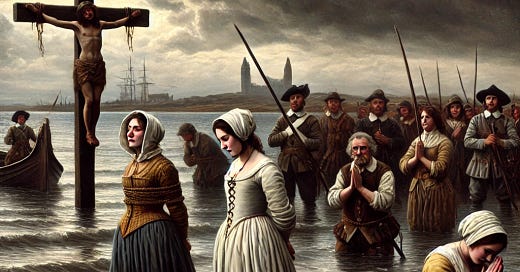Scotland’s religious history is filled with tales of persecution, defiance, and sacrifice, but few are as haunting as the story of the Wigtown Martyrs—Margaret Maclachlan and Margaret Wilson—who were allegedly drowned in the Solway Firth for refusing to renounce their Presbyterian faith. Their fate has become one of the most enduring legends of the "Killing Times" of the late 17th century, a period of brutal suppression of the Covenanters.
But was this execution a historical fact, or has it been mythologized over time?
The Covenanters and the "Killing Times"
To understand the fate of the Wigtown Martyrs, we need to look at the turbulent religious climate of 17th-century Scotland. The Covenanters were Presbyterians who opposed the attempts of Charles II and James VII to impose Episcopalian rule over the Scottish Church. They believed that only Christ, not the King, should be the head of the Church, and they refused to swear loyalty to the crown’s religious authority.
This resistance led to a bloody crackdown, and from 1680 to 1688, hundreds of Covenanters were executed, exiled, or imprisoned. These brutal years became known as the "Killing Times," and it was in this period that the tragic story of Margaret Maclachlan and Margaret Wilson unfolded.
The Arrest and Trial
The two women—one an elderly widow, the other a teenage girl—were accused of attending illegal conventicles (outdoor Presbyterian worship gatherings) and refusing to swear allegiance to King James VII.
Margaret Maclachlan was a 70-year-old widow who had long been known for her devotion to the Covenanting cause.
Margaret Wilson, just 18 years old, came from a Presbyterian family but had taken a stronger stand than her parents.
Both women were arrested in Wigtown in early 1685, along with Margaret Wilson’s younger sister, Agnes. The authorities gave them a choice: swear an oath of loyalty to the King and attend Episcopalian services—or face execution.
Margaret Wilson and Margaret Maclachlan refused.
The Execution at the Solway Firth
On May 11, 1685, according to traditional accounts, both women were sentenced to death by drowning in the Solway Firth, a body of water near Wigtown.
The elderly Margaret Maclachlan was tied to a stake further out in the water so that she would drown first, forcing the younger Margaret Wilson to watch.
Margaret Wilson, tied closer to the shore, was given another chance to swear loyalty to the King. Instead, she prayed aloud and sang psalms as the water rose around her.
When the tide reached her mouth, soldiers allegedly pulled her up and gave her one last chance to submit. When she refused, she was pushed back under, where she drowned in the rising tide.
Her younger sister, Agnes Wilson, was spared, likely due to her age and her father’s intervention.
The Controversy: Did the Drownings Actually Happen?
While this story has been passed down for centuries, some historians have questioned its accuracy.
Was There a Legal Execution Order?
The official records of the Privy Council of Scotland from 1685 do not contain a warrant for the execution of Margaret Wilson and Margaret Maclachlan.
However, there is a record of their sentencing, leading some to believe they were pardoned but later killed unlawfully by local authorities.
Was Margaret Wilson Secretly Executed in Prison?
Some historians believe Margaret Wilson might have died in prison, possibly from illness or mistreatment, rather than being drowned in the Solway.
Could This Be a Localized Act of Brutality?
Some argue that the execution was not officially sanctioned but rather carried out by overzealous local officials enforcing the harsh anti-Covenanter laws.
Despite these uncertainties, the story of the Wigtown Martyrs was recorded in contemporary Covenanting sources, including Robert Wodrow’s "The History of the Sufferings of the Church of Scotland" (1721), which cemented their place in Scottish religious history.
Legacy of the Wigtown Martyrs
Whether or not their drowning happened exactly as described, the Wigtown Martyrs became powerful symbols of religious persecution and martyrdom in Scotland.
A monument was erected in Wigtown Churchyard in their memory.
The site of their supposed execution, "The Martyrs’ Stake," is still visited today.
The story was used as a rallying cry by Presbyterians and later by Scottish nationalists as an example of oppression.
In 1858, Queen Victoria herself was moved to tears upon hearing the story, showing how deeply the legend had embedded itself in the national consciousness.
Fact or Myth? Why the Wigtown Martyrs’ Story Still Matters
Even if some details of the story are embellished, there is little doubt that Margaret Wilson and Margaret Maclachlan died for their faith. Whether by drowning, imprisonment, or another means, they were victims of a brutal era in Scottish history.
More importantly, their story serves as a reminder of the cost of religious freedom. Their defiance in the face of tyranny continues to inspire debate, reflection, and respect—making them more than just a legend, but symbols of the Scottish struggle for faith and freedom.





